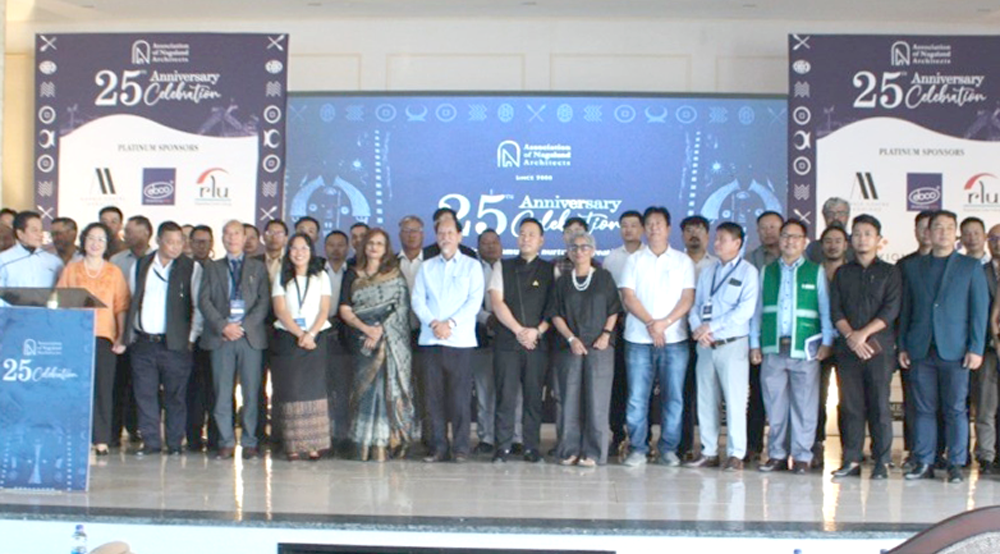The Association of Nagaland Architects (ANA) celebrated its 25th Anniversary on Friday under the theme “Celebrating Community, Nurturing Creativity” at JP Park & Banquets, 4th Mile, Chümoukedima. The event marked a milestone in the state’s architectural journey, bringing together architects, planners, and policymakers to reflect on 25 years of innovation, resilience, and commitment to sustainable design in Nagaland.
On arrival, Chief Minister Neiphiu Rio inaugurated the exhibition stall, which showcased a wide range of home and décor materials highlighting creativity, local craftsmanship, and evolving architectural practices.
Speaking as a Guest of Honour, Rio, stated that 25 years celebration is a remarkable milestone, a testament to vision, perseverance, and the unwavering commitment of a community of professionals dedicated to shaping the very fabric of our state. He thanked the principal Architect and Founder, Ar. Chitra Vishwanath for his pioneering work at Biome Environmental Solutions in Bangalore which has inspired a generation to build in harmony with nature.
Recalling the genesis of the Association of Nagaland Architects, Rio noted that ANA began as a group of passionate professionals who shared not just concerns but a common dream — to elevate architectural practice in Nagaland. “One of their earliest and most crucial initiatives was the ardent call for development controls and building bye-laws in our state. This was not merely a professional demand; it was a foundational step towards organized, safe, and sustainable urban growth,” he said.
The Chief Minister highlighted ANA’s growth from a small group to a strong body of over 120 registered architects serving as policymakers, government servants, private practitioners, and entrepreneurs. “Architects are more than designers of buildings; they are the custodians of our heritage, the interpreters of our culture, and the visionaries of our future,” Rio stated.
Download Nagaland Tribune app on Google Play

He observed that the architecture of Nagaland weaves traditional ethos with modern functionality. “Every structure they design, every space they plan contributes to the identity of Nagaland. The government deeply acknowledges and values their contributions. Their advocacy for a resilient and sustainable built environment aligns perfectly with our vision for a prosperous and responsible Nagaland,” he said.
Referring to the state’s vulnerability, Rio reminded that Nagaland falls under Earthquake Zone 5 — the highest risk zone. “This is not a statistic in a manual; it is a reality that governs our lives. It demands not just compliance but ingenuity. Architects must be at the forefront of innovation,” he urged, calling for designs that balance beauty with uncompromising safety.
Highlighting the construction sector as the largest source of employment in the state, Rio said it provides livelihoods to thousands of youth and presents immense economic potential. He called upon ANA and its members to take the lead in training and empowering local workers, masons, and artisans. “By introducing new technologies, modern techniques, and sustainable practices, you are not just constructing buildings—you are constructing careers and strengthening our economy,” he emphasized.
The Chief Minister urged the Association to continue its mission with passion and purpose. “Be the innovators who balance safety with aspiration, the mentors who empower communities, and the visionaries who build a Nagaland that is not just beautiful, but resilient, sustainable, and a home we can all be proud of,” he said.
Dr. Gauri Nitin Shiurkar, Member of the Council of Architecture (India), in her address, said that ANA’s silver jubilee marked not just the passage of time but the perseverance of a collective dream. “It is a journey of ideas, of people, and of purpose. Nagaland’s architecture is deeply rooted and expressive—a reflection of resilience, identity, and community wisdom,” she said.
Dr Shiurkar highlighted how traditional Naga architecture has long embodied sustainability. “Long before the world spoke of green architecture, Nagaland practiced it naturally and intuitively. The way bamboo, timber, and stone are used reflects deep respect for climate, terrain, and craft,” she said, adding that modern architects are now reinterpreting these traditions by blending past wisdom with future aspirations.
“Nagaland stands today as a living laboratory of sustainable and cultural architecture—a place where every building whispers the language of the hills, forests, and people who shape it,” she said.
Dr Shiurkar further stated that true architecture is about belonging — connecting people, culture, and the environment. “Technology may draw the lines, but humanity gives them meaning,” she said, emphasizing four strategic pillars for advancing the profession: curriculum reforms, capacity building, digital integration, and sustainable, inclusive design.
She observed that with Nagaland focusing on eco-tourism, rural development, and infrastructure, architects have a pivotal role in shaping the region’s future. “Nagaland can truly emerge as a beacon of regional and sustainable architecture—demonstrating how design can be rooted, relevant, and revolutionary at the same time,” she added.
Earlier, ANA President Ar Apokla Jamir delivered the welcome address, while Ar. Medozho Zhango presented “A Moment in Time.” The event also featured a Material Expo, project presentations, insights from eminent architects, and a panel discussion on “Licensing and Regulating Construction Workers with a Special Focus on North East India.”
Chief Minister Neiphiu Rio also released the Jubilee Magazine and paid tribute to the first Naga Architect, late C Yantsushan Murry, along with other pioneering architects of the state.

